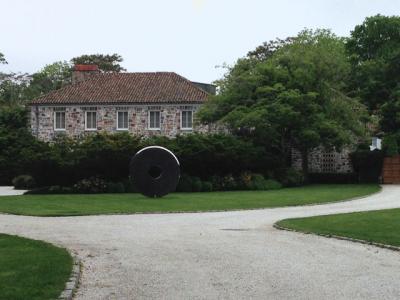No Love Lost Over Luxe Tennis Court

A dispute over a tennis court at 127 Main Street, the former Gardiner estate, landed in the court of the East Hampton Village Zoning Board of Appeals on Friday.
In 2014, the owner of the 5.4-acre property, Shahab Karmely, a real estate developer, had sought and received setback variances to construct a court at the rear of the parcel, a deep lot that runs from Main Street to the John M. Marshall Elementary School’s playing fields. The court had to be placed in a north-south configuration, he said, because sunlight would make an east-west layout unplayable for most of the day.
Kenneth Kuchin, who owns 121 Main Street, was worried about noise, given the proposed court’s proximity to a cottage he uses for meditation. Another possible location, midway between the main house and the rear property line, drew objection from Thomas Osborne, who owns vacant land on the other side. The court could have been built elsewhere, in a conforming location, but that would have necessitated the removal of large specimen trees and a historic boxwood allee.
The zoning board accepted the original proposal and approved the application, but required that Mr. Karmely sink the court four feet below grade, install a Har-Tru surface, which is quieter than a hard surface, and buffer it with mature landscaping.
When the Building Department inspected the property to issue a certificate of occupancy, however, the landscaping was found not in accordance with the 2014 approval. Inspectors also discovered that Mr. Karmely had added a viewing area that was not in the original plans.
Both properties are listed for sale, Mr. Karmely’s for $26 million and Mr. Kuchin’s for $11.95 million.
Friday saw a lengthy volley between board members and Mr. Karmely’s lawyer, Andy Hammer. The landscaping plan submitted in 2014 was “a boilerplate plan,” said Mr. Hammer, explaining that his client saw no need for additional landscaping because the property is already bordered by 30-foot-high trees. “What we’re essentially asking is that the board approve the court as it was built, which is quite a lovely court,” the lawyer said.
But it is not four feet below grade as stipulated in the approval, said Frank Newbold, the board’s chairman. It is closer to two feet, he said, and the excavated soil was used to create an approximately two-foot-high berm around its perimeter. The original sketches, Mr. Newbold said, showed a set of steps on either side, but the court as built includes a 10-by-20-foot paved viewing area, a larger staircase, a buffet area with refrigerator, and a storage box, apparently housing irrigation equipment.
“When we approved it, we were trying so hard to make it palatable to the neighbors,” said Lys Marigold, the board’s vice chairwoman. “Now there’s, like, a party area,” she said, despite the emphasis on toning down noise. “We gave substantial relief . . . you submitted plans, and the plans were to be followed.”
Mr. Hammer said he would consult with the court’s builder, but pointed out that “you could build a court on this property more or less as of right if you just orient it in the other direction” — something Mr. Karmely, in 2014, warned the board would happen if his request was denied.
The board, Mr. Newbold replied, had granted substantial variance relief, reducing the side-yard setbacks by roughly half. The application, he repeated, had been carefully vetted to minimize noise, and restrictions were added.
Mr. Hammer offered his recollection that the chairman had called the proposal the most beautiful tennis court he had seen. “I don’t play tennis,” Mr. Newbold shot back.
Mr. Kuchin, the neighbor, then spoke. “The noise is terrible,” he said. “I don’t know what I can do.” Mr. Newbold encouraged him to consult with the village’s code enforcement officers. The hearing was left open and is scheduled to continue on Friday, June 10.
Also at the meeting, the board announced five determinations. Keith and Anne Cynar of 52, 54, and 56 McGuirk Street were granted variances to allow 50 square feet of lot coverage over the maximum permitted and to install a swimming pool. Their property, which was developed before zoning laws were enacted, has three separate buildings, one of which contains two residential units. The variances were granted on the condition that the Cynars extend driveways to accommodate multiple vehicles, as the pool will occupy space previously used for parking.
Dexter Goei of 207 Lily Pond Lane was granted freshwater wetlands variances to allow modifications, alterations, and additions to structures previously approved. These include the driveway’s reconfiguration and the addition of retaining walls, patios, walkways, a pool house, a garage, and a sanitary system within the required wetlands setback. All plantings within 125 feet of the wetlands boundary must be native vegetation, and there can be no use of fertilizers within that zone. The driveway must be permeable gravel, and project-limiting fencing must be installed and maintained throughout the course of construction.
Bradford Peck’s request to legalize habitable space and plumbing on the second floor of a garage at 5 Jericho Lane was denied, but he was allowed to keep a basketball hoop and an air-conditioning unit in place and to relocate a shed, all within required setbacks. He was also granted variances to permit 360 square feet of coverage over the maximum permitted by code.
The board granted Michael LaRocca of 100 Dayton Lane variances to reconstruct a swimming pool within required setbacks and replace a garage door within a pre-existing sideyard setback with a larger door.
And, at 116 Apaquogue Road, a wetlands permit and variances will allow Gerald Breslauer to install children’s play equipment within the required 150-foot wetlands setback.
